Introduction and summary
Tumwater, Washington, a small suburb of Olympia in the shadow of Mount Rainer, is home to Janna and Andrew Ryan and their 3-year-old son, Elliott. Janna and Andrew both commute into Olympia each day for their jobs working for the state government. For years, they have struggled to find quality, affordable child care for their young son.1
Although Washington state passed a paid leave law in 2017,2 Elliott was born in 2016, and therefore, Janna and Andrew took mostly unpaid leave to care for him during the first few months of his life. With new expenses piling up on items such as diapers and baby equipment, the Ryans’ parenthood started in a financial hole due to their increased expenses and decreased income. Knowing that child care options for infants were limited, Janna and Andrew got on a waitlist well before Elliott was born and were able to find a spot for him when he was 6 months old at a child care center in their neighborhood. However, they quickly found that child care was their largest monthly expense—exceeding the cost of their monthly rent. Despite both working full-time jobs that placed their family income just above the state average, the Ryans struggled to manage their family budget. They no longer had money left over at the end of the month to save for a down payment on a house.
Although child care tuition was the Ryans’ largest monthly expense, they soon had concerns about the quality of the program. While the facility was clean and new, policies related to parent communication and safety protocols were either lacking or not followed consistently, leaving the Ryans concerned about their son’s well-being. Janna spent hours researching alternative options and had to take time off work to tour programs. The limited availability of infant and toddler care left Janna and Andrew facing a decision about the inevitable trade-offs they would have to make. They wanted a robust curriculum, experienced and capable staff, and a location convenient to home and work, but they also had a limited budget. In September 2017, Elliott moved to a child care program that Janna and Andrew love. The program has been operating for 30 years, is staffed by experienced teachers, and focuses on teaching empathy and acceptance. Unfortunately, the Ryans recently found out that it is closing because the center’s landlord is not renewing the lease, and operating costs are too high. As a result, Janna and Andrew are now back on the hunt for affordable child care. Meanwhile, they are putting off their plans for a second child. They would really like Elliott to have a sibling, but the cost of child care for two children is just too big of a hurdle.
This is the reality of the early childhood education system in the United States today. For families with only one income or those working minimum wage jobs, the struggle is even more acute. Families across the country are struggling to afford the cost of child care, and what they pay in tuition does not necessarily translate into high-quality child care or livable wages for early childhood teachers. As Janna said, this “feels like a giant math equation that doesn’t quite add up.”3
The high cost of child care, coupled with low teacher wages and quality concerns, is confusing to parents and policymakers alike. To understand what is driving the disconnect between what parents are paying and what teachers are earning, it is important to understand the finances of early childhood programs and what drives the high cost.
Using data from the Center for American Progress’ “Where Does Your Child Care Dollar Go?” tool and new analysis that estimates the cost of home-based family child care, this report looks at this “giant math equation” specifically as it relates to infant and toddler care. The report provides state-by-state estimates of the cost to provide child care that meets minimum state licensing standards, as well as the cost to provide high-quality child care where early childhood educators earn salaries comparable to kindergarten teachers. The data find that child care for infants and toddlers is significantly more expensive than it is for preschool-age children. Moreover, by analyzing the estimated costs in relation to average family incomes, it is clear that the cost of child care for infants and toddlers is beyond what most families can afford. Similarly, a review of public funding to help families access child care finds that this child care assistance reaches only a fraction of eligible families and is insufficient to cover the true cost of infant and toddler care.
Key findings from this analysis include:
Licensed infant and toddler child care is unaffordable for most families:
- The average cost to provide center-based child care for an infant in the United States is $1,230 per month. In a family child care home, the average cost is $800 per month.
- On average, a family making the state median income would have to spend 18 percent of their income to cover the cost of child care for an infant, and 13 percent for a toddler.
- In no state does the cost of center-based infant or toddler child care meet the federal definition of affordable—no more than 7 percent of annual household income. In 12 states, the cost of child care for just one infant exceeds 20 percent of the state median income.
Current public investments in infant and toddler child care fall short:
- On average, child care for an infant costs 61 percent more than for a preschooler, yet child care subsidy rates are only 27 percent higher for infants than preschoolers.
- Child care subsidies only cover the average cost of care for an infant in three states—Hawaii, Indiana, and South Dakota.
- The gap between the child care subsidy rate and the cost of licensed infant care exceeds $400 per month in nearly half of all states.
To address these findings, policymakers can take some immediate actions, such as conducting a full cost-of-quality study and updating child care assistance policies, but they must also look to longer-term solutions such as increasing pay for infant and toddler teachers and enacting comprehensive child care reform.
This report begins with an explanation of the cost models that CAP developed and presents data from the models on the average cost in order to provide infant and toddler child care that meets state licensing standards, as well as child care that meets higher-quality standards. Following this, the report reviews the current revenue streams available to providers. Using state median income data, the report calculates the percentage of average income that families would have to spend if market rates reflected the true cost of providing licensed infant and toddler child care; and it reviews the sufficiency of current child care subsidy rates. Finally, the report provides six policy recommendations to address the affordability of infant and toddler child care.
The benefits of high-quality infant and toddler child care
Children begin learning at birth. Every interaction that young children have with a caregiver adds to their experiences, which in turn influences the rapid brain development that occurs in the first few years of life and lays the framework for success throughout life.4 While it sometimes might seem like infants just eat, sleep, and need diaper changes, they are also taking in the world around them and responding to caregivers’ voices and facial expressions.5 After parents, teachers have the most significant role in harnessing children’s opportunities for development that arise in the early years. As such, the ability of families to access child care programs staffed by highly skilled and experienced teachers can have a major impact on children’s cognitive development.
Unfortunately, nearly 1 in 5 infants and toddlers in the United States live in poverty, leaving millions of children at risk of falling behind before they can even walk.6 The toxic stress associated with poverty can limit young children’s exposure to positive interactions and harm brain development. Children of color fare even worse, with around 1 in 3 African American and Hispanic children living in poverty.7 It is no surprise that gaps in children’s cognitive abilities by income are evident as early as 9 months old and significantly widen by the age of 2.8 Ensuring all families have access to affordable, high-quality child care can help mitigate some of the impacts of poverty and prepare children for success in school and beyond.9
The benefits of high-quality, licensed child care also extend to parents and the wider society. Access to affordable, high-quality child care can help parents pursue their careers, work longer hours, or attend school10 and can have a long-term impact on families’ economic security.11 When families have access to reliable child care, parents are more productive, and mothers are more likely to work.12 Economists estimate that if child care costs were capped at 10 percent of family income, the United States would see a gross domestic product (GDP) gain equal to $210.2 billion and a corresponding $70 billion annual increase in federal tax revenue—both due to increased earnings.13
In addition to the immediate impact of affordable, high-quality child care, researchers find that access to this care produces significant societal savings for decades into the future. Participants are more likely to have improved health outcomes, increased future earnings, and reduced crime rates, meaning each dollar spent on early childhood programs is paid back several times over.14
The cost of quality infant and toddler child care
It is no secret that child care can be costly, and this is especially true for infant and toddler child care. Annual child care often exceeds the annual cost of college tuition and is one of the largest expenses in a family’s budget.15 However, high child care tuition rates rarely cover the full costs that providers incur but rather reflect what parents can afford to pay and what the local market can bear. For example, in addition to tuition fees, providers may be relying on in-kind donations, reduced or free rent, or extensive fundraising to cover their costs.16
With nearly 250,000 licensed child care providers in the United States, operating costs vary widely, making estimating the cost of child care an imprecise science.17 However, the process of cost modeling can help to understand the overall economics of child care and the impact of public policy on child care businesses and family affordability. In developing a model, it is necessary to make several assumptions about the hypothetical program. These can be informed by data but also rely on the professional judgment of experts with experience in this field.
On average it costs $1,230 per month, or nearly $15,000 per year, to provide child care for an infant in a child care center in the United States.
To help illustrate the gap between current child care prices and the real cost to provide high-quality child care, the Center for American Progress developed a 50-state cost model for center-based programs.18 To compliment this tool, CAP created a model to estimate the cost of home-based family child care.19 The baseline assumptions used in these models are informed by state licensing regulations, data from the Provider Cost of Quality Calculator, and the National Survey of Early Care and Education.20 The baseline model represents the cost to operate a program that meets each state’s licensing regulations and pays teachers the average child care teacher salary for that state. Table 1 details the key assumptions included in this model.
 Based on this analysis, on average, it costs $1,230 per month, or nearly $15,000 per year, to provide child care for an infant in a child care center in the United States. Figure 1 illustrates the difference in cost per child based on age, with preschool cost data included as a comparison.
Based on this analysis, on average, it costs $1,230 per month, or nearly $15,000 per year, to provide child care for an infant in a child care center in the United States. Figure 1 illustrates the difference in cost per child based on age, with preschool cost data included as a comparison.
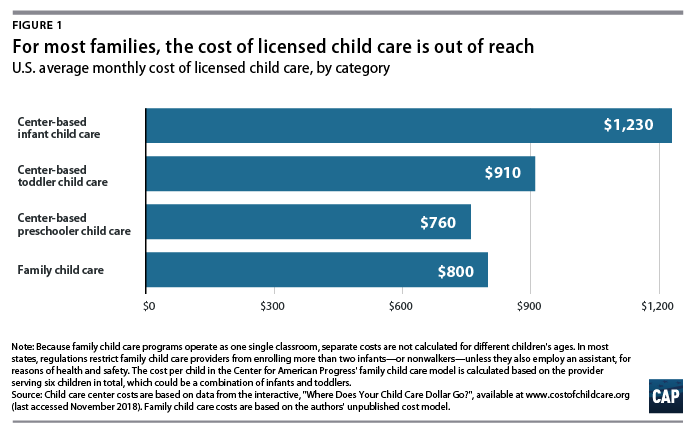
Teacher and nonteacher staff salaries and benefits are the No. 1 expense driving this cost, accounting for between 56 and 68 percent of program expenses. As shown in Figure 2, in classrooms serving the youngest children, salaries and benefits take up a larger share of expenses due to smaller class sizes and lower adult-child ratios.
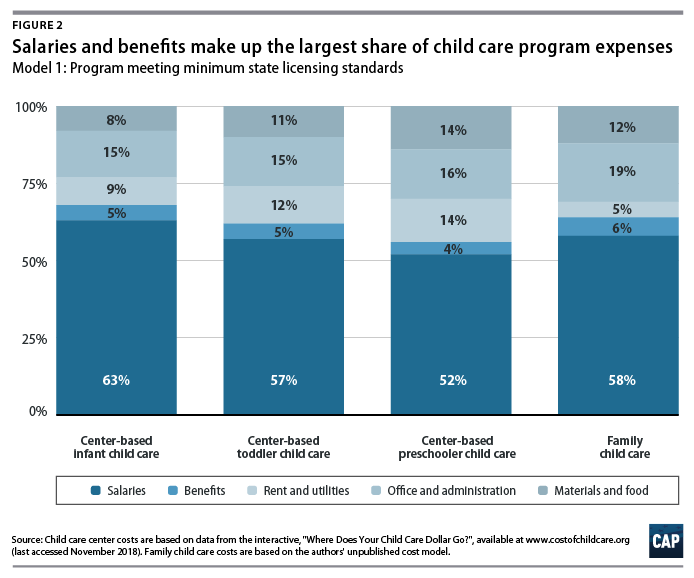
Table 6 in the Appendix provides a state-by-state list of costs by child’s age and setting.
Where does your child care dollar go?
For many families, spending $1,230 a month for center-based infant child care is a significant strain on their budget or is entirely out of reach. However, even this high monthly cost leaves child care centers struggling to cover their costs. The sample budget in Table 2 below uses data from CAP’s cost model to illustrate the breakdown of expenses in a child care center’s infant classroom:21
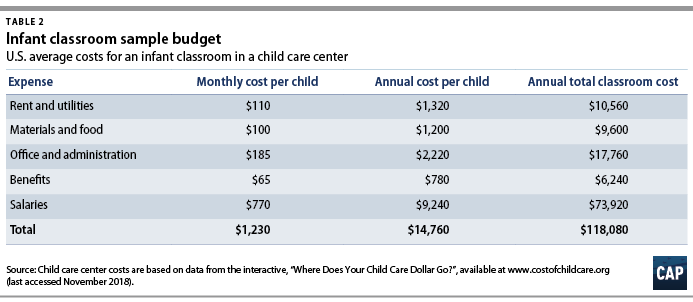
As shown above, even if the infant classroom is full—with all eight children paying tuition in full and on time—there is slightly less than $74,000 available annually to pay the salaries of the two teachers in the classroom and to cover the share of nonteaching staff such as the director or administrative assistant.
In a family child care program, the problem is similar. In small, home-based programs, the entire family child care program can be viewed as one classroom. The family child care sample budget in Table 3 below shows that even with families paying $800 per month, there is little left over for the provider to purchase benefits or reinvest in their program. Assuming the provider enrolls six children, its income would be only about $33,000 per year.
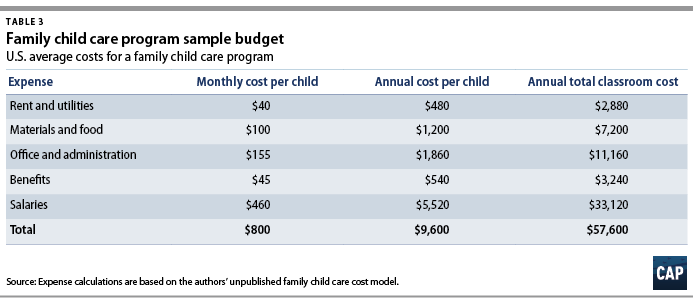
Looking at the data in this way, it becomes apparent that the system is broken: Parents are stretched thin, teachers are underpaid, and programs are struggling to stay solvent.
Impact of program quality on the cost of infant and toddler child care
While the costs above represent a program meeting minimum state licensing standards, many providers offer lower teacher-student ratios or group sizes than required by licensing—especially in states where ratios are particularly high and do not align with developmentally appropriate best practice.22 In addition, using average child care salaries embeds current low wages in the model, producing a cost estimate that relies on an underpaid workforce.
Early childhood teachers have long been undervalued, and child care is one of the lowest-paid professions in the United States; the average early childhood teacher makes just $10.72 per hour.23 Teachers of infants and toddlers fare even worse, earning $2 less per hour, on average, than teachers serving children ages 3 to 5, even when they have the same credentials.24 In addition, the gender and racial inequities that exist in the broader U.S. labor force are reflected in the early childhood field: 40 percent of the workforce are women of color, and African American teachers are disproportionally more likely to work with infants and toddlers.25
Higher wages are critical to retain experienced and skilled early childhood educators who can foster positive interaction with young children and provide a structured learning environment.26 Teachers who are worried about how they are going to provide for their own family cannot be expected to give their full focus to the children in their care.27 Higher wages also reduce teacher turnover, which can be especially disruptive to young children.28 Having a consistent caregiver can help infants and toddlers build trust and develop relationships, which in turn provides foundational security that allows young children to confidently explore the world around them.29
To better understand the cost of a high-quality infant and toddler child care program, the authors created a high-quality child care center and family child care home model in which salaries and benefits are aligned with kindergarten teacher compensation and in which ratios and group sizes are aligned with age-appropriate best practice, as defined by the National Association for the Education of Young Children.30 Table 4 details the assumptions used in this high-quality care model.

As shown in Figure 3, the average monthly cost of center-based infant child care increases by nearly $1,000 once these quality improvements are accounted for.
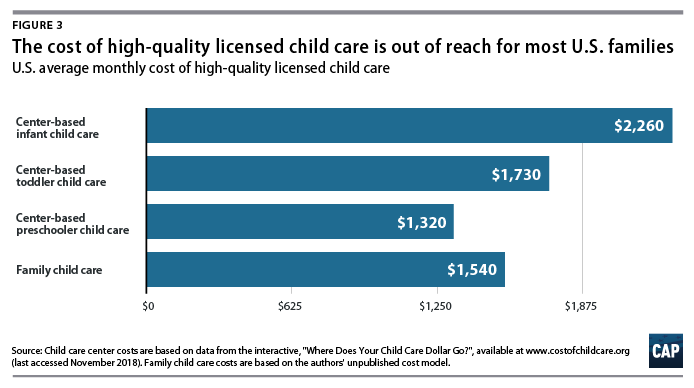
Paying higher salaries also increases the cost gap between child care for infants and preschoolers. Infant care in the high-quality care model costs nearly $1,000 more than care for a preschooler, compared with a $500 difference in the model that considers only licensing standards. The increased salaries in the high-quality care model drives the higher cost, with compensation accounting for between 68 and 76 percent of total expenses in this model, as shown in Figure 4.

Table 7 in the Appendix summarizes the results of the high-quality care model for each state.
Impact of program characteristics on the cost of infant and toddler child care
In addition to teacher-student ratios and teacher wages, program size and the ages of children enrolled also affect the finances of a child care program. Like any business, child care providers benefit from economies of scale. In a larger program, more revenue from tuition covers fixed costs—such as licensing fees, utilities, and program administrators—that do not vary based on the number of children enrolled. However, with almost two-thirds of child care centers serving less than 75 children, many are left struggling to break even.31
Serving infants and toddlers alongside preschoolers is also key to financial solvency. To offset the high cost of infant care, providers can use revenues from older children to subsidize the costs associated with infant care. For example, the authors’ model suggests that programs need to charge $2,260 for an infant and $1,320 for a preschooler in order to provide high-quality child care. However, to make infant care more affordable for families, a program could instead spread costs across age groups, charging $1,800 for an infant and $1,500 for a preschooler while still taking in the same amount of revenue.
For safety reasons, when infants are enrolled in family child care homes, most states limit the total number of children for which providers can care. For example, a provider may be licensed to serve up to eight children; but if they enroll just one infant, they might only be able to serve five additional children.32 As a result, by enrolling infants, family child care providers limit the total amount of revenue they can generate, which can act as a disincentive to accept any infants.
The unintended consequences of preschool initiatives
As an increasing number of states and cities make needed investments in preschool,33 they should consider the impact that these initiatives can have on access to infant and toddler child care. If initiatives only support access to preschool in public school programs, community-based child care providers will struggle to stay afloat due to the loss of revenue from preschool enrollment.34 This can have a devasting impact on the already limited supply of infant and toddler care.35
Policymakers can mitigate this impact by designing initiatives that include community-based programs. For example, West Virginia requires at least 50 percent of classrooms funded by its universal preschool program to be offered in collaboration with community partners.36 And in New York City, 60 percent of preschoolers enrolled through the city’s “Pre-K for All” initiative attend community-based programs.37
Shared services alliances
Shared services alliances or staffed family child care networks represent an emerging strategy to support small providers and family child care homes. These alliances or networks can support program operations, helping to increase program efficiency and centralize administrative services, such as fee collection and subsidy administration, thus freeing up program directors to focus on pedagogical support.38 While there are many different ways to organize an alliance or network, these strategies usually include a central hub organization that provides and coordinates support to members. The network hub is funded either by member fees or by philanthropic or other outside support.
As part of an alliance, providers can also increase their purchasing power, buy supplies in bulk, enter into collaborative contracts for support services such as maintenance, and share administrative staff to reduce nonteacher personnel costs. In this way, shared services alliances can help providers maximize revenue and reduce costs, as well as help teachers and directors focus on their core mission of educating children.39
Paying for infant and toddler child care
Limited public funding forces families to shoulder the majority of the burden of paying for child care.40 The high cost of infant and toddler care comes at a time when families can least afford it.41 New parents are unlikely to have achieved their full earning potential by the time they have children, and they face new expenses that come with having a baby.42 It is unsurprising, then, that of all age groups, children less than 3 years old are the most likely to live in poverty: 44 percent of children less than 3 years old live in low-income households, compared with 29 percent of working-age adults.43
On average, parents would need to spend 18 percent of their annual income just to purchase infant child care that meets licensing standards.
The true cost of quality infant and toddler child care is unaffordable for most families
While the U.S. Department of Health and Human Services defines child care as being affordable when it does not exceed 7 percent of family income,44 data from CAP’s models find that if market rates reflected the real cost of providing that care, families in every state would pay a much higher share of their income to access infant and toddler care that meets minimum state licensing standards.The true cost of quality infant and toddler child care is unaffordable for most families
Table 5 shows how much parents would need to spend, on average, to cover the true cost of child care that meets state licensing requirements and how much they would have to spend to cover the cost of a higher-quality program. On average, parents would need to spend 18 percent of their annual income just to purchase infant child care that meets licensing standards.
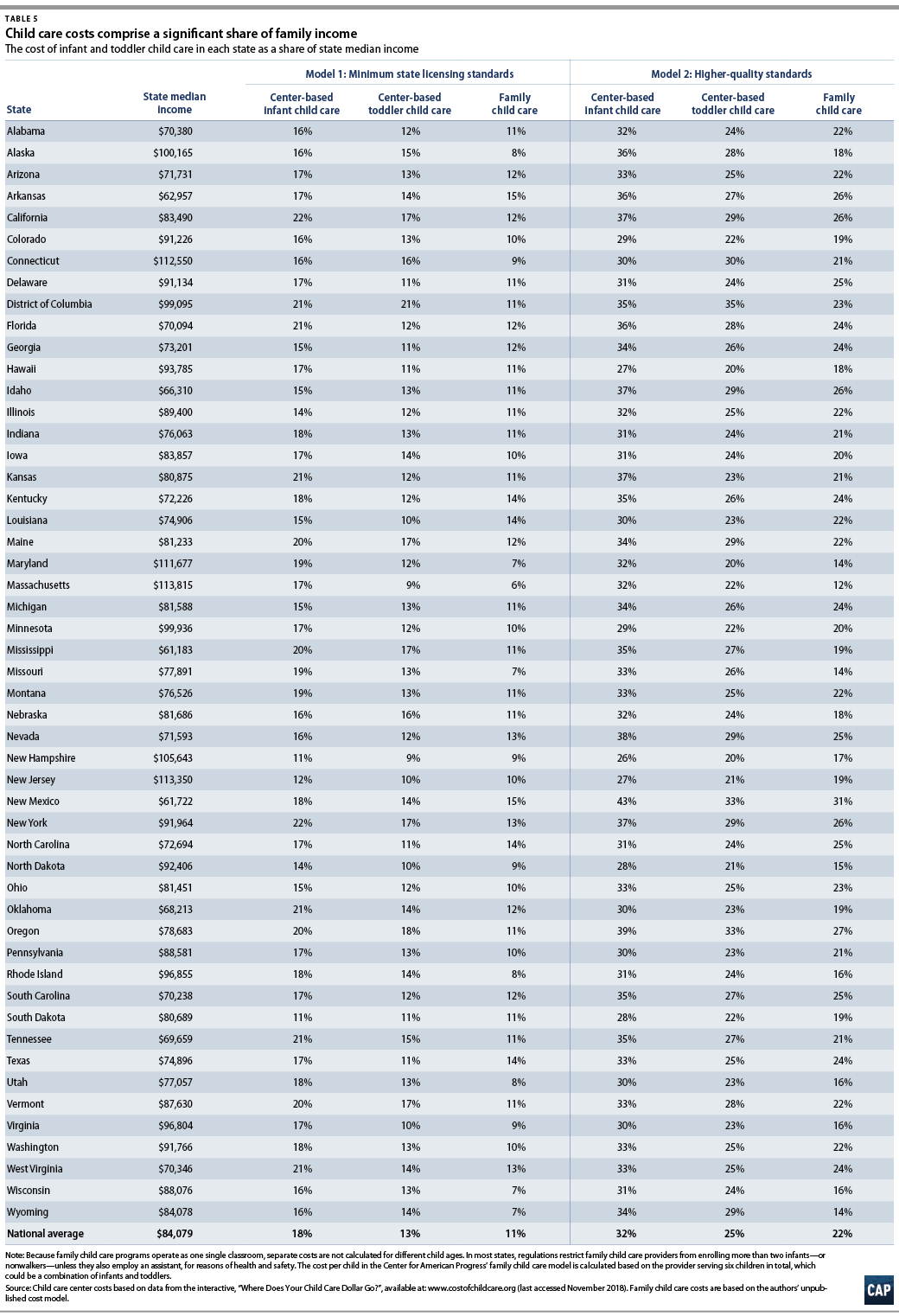
Child care subsidies are insufficient to cover the true cost of infant and toddler child care
The Child Care and Development Block Grant (CCDBG) is the federal funding source to help families pay for child care. However, a lack of funding means only 1 in 6 eligible children actually receives a child care subsidy, limiting the program’s impact.45 Furthermore, the high cost of infant and toddler care is rarely covered by the subsidy payment that providers receive, potentially discouraging providers from accepting subsidy-eligible infants and toddlers.
The cost of providing care for an infant is, on average, 61 percent higher than the cost of serving a preschooler. However, the infant subsidy rate is, on average, only 27 percent higher than the preschool subsidy rate.
While all states provide higher child care subsidy payments for younger children, in most cases, this higher rate is insufficient to cover the difference between the cost of serving infants and serving older children.46 Based on CAP’s models, the cost of providing care for an infant is, on average, 61 percent higher than the cost of serving a preschooler. However, the infant subsidy rate is, on average, only 27 percent higher than the preschool subsidy rate. In only eight states does the increase in the subsidy rate match the increased costs. Table A3 in the Appendix provides these data for each state.
Figure 5 quantifies the financial gap that providers face when serving infants through the child care subsidy system, ranking all 50 states and Washington, D.C., by the size of the gap between their child care subsidy rate—as of 2016—and the true costs of providing licensed center-based child care.47 The largest gap exists in Maryland, where the cost of providing care for an infant is more than $900 more per month than the subsidy reimbursement rate. In only three states—Indiana, South Dakota, and Hawaii—does the reimbursement rate cover the estimated cost of infant care that meets state licensing standards, but it still falls far short of the cost of a high-quality program. The recent 80 percent increase in discretionary federal funding for the child care subsidy program is a welcome opportunity for states to increase reimbursement rates in order to start addressing these gaps.48
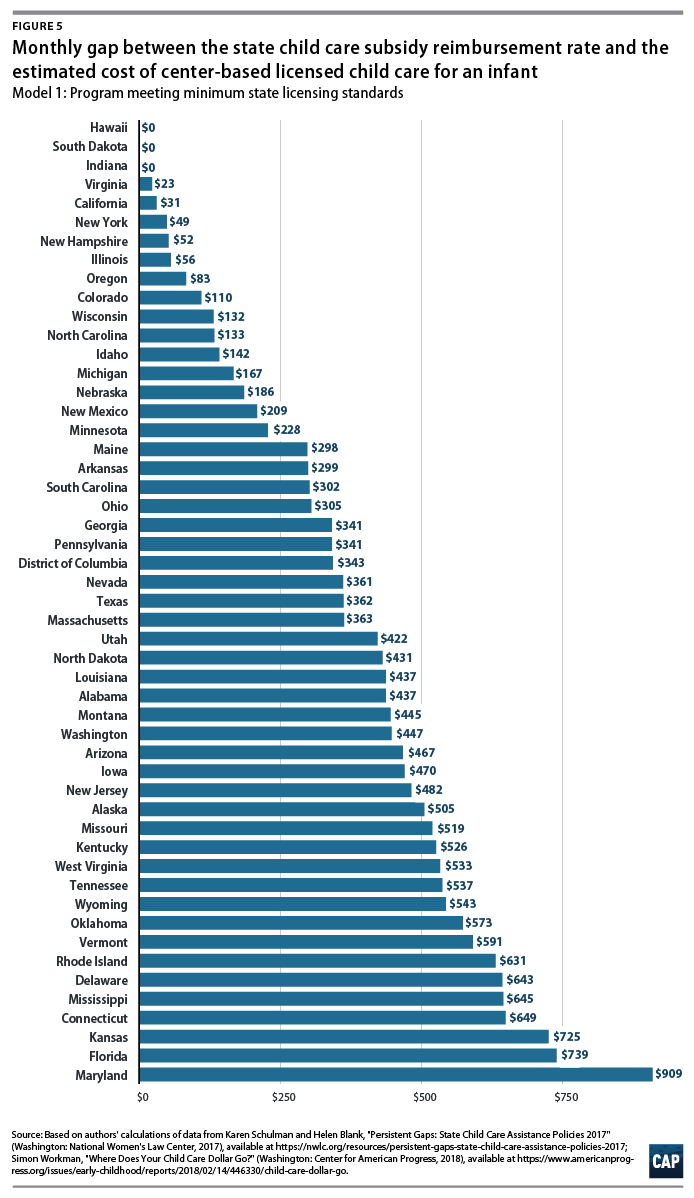
Policy solutions to help families access high-quality infant and toddler child care
The disconnect between the cost of child care and what parents can afford to pay—coupled with the lack of public funding—highlights the central challenge at the heart of the U.S. early childhood system today. While the United States has been slow to invest in early childhood education, compared with many other developed counties, recent polling shows that voters want policymakers to act. Nearly 80 percent of respondents to a recent national CAP survey supported improving the quality of child care and making it affordable for parents, and nearly 70 percent said they would be more likely to vote for a candidate who supports these policy ideas.49
There are several policy responses states and communities can pursue to address this need:
Conduct a cost-of-quality study to fully understand the true cost of child care
The data provided in this report use state and national averages drawn from a variety of sources. While this helps illustrate the significant gaps between current revenue streams and the true cost of quality, conducting a full cost-of-quality study would allow states and communities to better estimate the specific cost of delivering high-quality child care in their area.
Enact subsidy policies that support infants and toddlers
States should use the results of a robust cost-of-quality analysis to set subsidy reimbursement rates that reflect the true cost of quality. This should include different rates for each age group that are based on the actual difference in the cost of providing each group care. States can also explore ways to use the subsidy system to incentivize providers to serve infants and toddlers, such as contracting for infant and toddler slots.50
Use QRIS incentives to support infants and toddlers
Quality rating and improvement systems (QRIS) are a way for states to measure and support quality in their early childhood system.51 Many QRIS offer financial bonuses, quality awards, and increased subsidy reimbursement rates to programs that achieve the highest ratings in the system. However, state policies must help all providers achieve a minimum level of quality, providing resources to meet state licensing requirements and offering supports to make quality improvements—not just rewarding providers after they have achieved higher quality. States can tailor additional incentives to encourage high-quality providers to serve infants and toddlers and to ensure that financial incentives are sufficient to cover the actual cost of providing high-quality infant and toddler care.52
Support providers in all settings
While the majority of young children in licensed child care attend a center-based program, many families—especially families of infants and toddlers—choose a home-based family child care provider.53 Unfortunately, the number of licensed family child care providers has seen a significant decline in recent years, reducing the already limited supply of infant and toddler child care.54 States should provide supports to ensure home-based care can be a financially sustainable business. One way that states can do this is by supporting the development of staffed family child care networks. These networks bring groups of family child care providers together, pooling resources and building a community, and are a promising strategy for realizing some economies of scale for small family child care businesses.55 States can provide financial and nonfinancial support to help start new networks, including by offering start-up grants and technical assistance to organizations developing networks.56
Increase pay for infant and toddler teachers
The wage penalty many teachers face when working with the youngest children means infant and toddler classrooms are less likely to be staffed by teachers with bachelor’s degrees or many years of teaching experience.57 To address the overall low pay across the early childhood sector, states can set up wage boards that are charged with making recommendations for a wage ladder, as well as compensation standards that are based on experience and qualifications.58 In addition, states can develop targeted initiatives to support infant and toddler teachers. For example, subsidy increases can be designated specifically for workforce compensation for infant and toddler teachers—and states can look to targeted wage enhancement initiatives or teacher tax credits. States can also look to reduce barriers to higher education for teachers working with infants and toddlers, including by making sure professional development is available where and when teachers need it and by providing scholarship support.
Enact comprehensive early childhood education reform
Significant public investment is ultimately the only way to address the lack of affordable, quality child care in the early childhood system. In states, governors and state legislators can prioritize funding for early childhood in order to make significant changes to their subsidy systems, increasing the number of eligible families and increasing the reimbursement rate providers receive to actually cover the cost of a high-quality program.
At the federal level, the Child Care for Working Families Act—introduced in Congress in 2017—provides a comprehensive model of a progressive early childhood system.59 If passed, the bill would dramatically increase eligibility for child care subsidies to cover most working families and would limit family contributions at no more than 7 percent of family income, ensuring all families pay their fair share. The bill would also increase subsidy rates to cover the true cost of a quality program, ensuring that providers can operate a high-quality program and that teachers are paid a livable wage. In 2018, Congress provided a down payment on this legislation by expanding federal funding for child care assistance, but further investment is needed to address chronically low funding in the child care system.
Conclusion
Janna and Andrew Ryan’s experience searching for child care is not unique. It is costly to operate a licensed child care program that meets the needs of working families, young children, and early childhood teachers. Yet this high cost is out of reach for most working families, and current levels of public investment are insufficient to close the gap between what parents can afford to pay and the true cost of a quality program. In the long term, it is clear that the “giant math equation” can only be solved with a significant increase in public investment in early childhood education, particularly for infants and toddlers. Given the rapid brain development that occurs in the first three years of a child’s life and the impact early experiences have on future success, it is essential for this investment to be made early and for efforts to close the achievement gap not to wait until children enter kindergarten. The near- and long-term benefits for children, their families, and society make early childhood education a worthwhile investment—one that is critical to the future prosperity of the United States.
Acknowledgments
The authors wish to thank Janna, Andrew, and Elliot Ryan for sharing their story for this report; Anne Mitchell for her advice and guidance on the development of the cost models that produced the data used in this report; and Katie Hamm for her review and feedback throughout.
About the authors
Simon Workman is the associate director of Early Childhood Policy at the Center for American Progress.
Steven Jessen-Howard is a research assistant for Early Childhood Policy at the Center.
Appendix